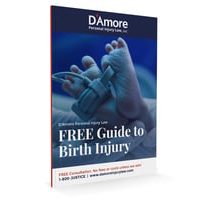Shoulder Dystocia
Our birth injury attorneys know how to win your child’s case.
What is Shoulder Dystocia?
Shoulder Dystocia is a medical term used by doctors to describe a situation where a baby’s shoulder gets “stuck” against the mother’s pelvic bone as the baby pushes through the birth canal. It occurs in less than 1% of all live births in the U.S.In the vast majority of cases, doctors are able to release the baby’s shoulder without causing any permanent injury to the baby by gently manipulating the baby’s head.However, if the doctor is not careful, or if the dystocia is too severe, a stretching injury can occur to the brachial plexus nerve bundle at the base of the baby’s neck. In some children, this can lead to a lifelong disability.
What are the warning signs of shoulder dystocia?
- The “turtle sign during labor” – this is when the baby’s head will appear but will retract back into the birth canal, similar to a turtle’s head going in and out of its shell. This is usually paired with the baby having a red, puffy face.
- The baby may be suffering from discomfort or nerve damage in the injured area.
- The baby may have a claw-like hand.
- In more serious cases, the child may also suffer paralysis of the affected limb, known as Erb’s palsy.
- A broken collarbone can also be the result of shoulder dystocia.
- And finally, bruising of the affected area.
High risk warning signs of shoulder dystocia during pregnancy
While there is no definitive sign of shoulder dystocia risk, below are the factors which are most commonly identified in pregnant women where a shoulder dystocia occurs during birth.
- Mothers who have had babies with shoulder dystocia before
For mothers who have had babies with shoulder dystocia before, the likelihood of it reoccurring is around 10%. If a previous baby encountered a shoulder dystocia, it is important to make your doctor aware so that appropriate preventative measures can be put in place prior to labor.
- Fetal macrosomia
Most babies are born weighing between 5lbs 11oz to 8lbs 6oz. Babies which are born with a weight in the 90th percentile (over 8lbs 13oz) are at higher risk of shoulder dystocia due to their size.
- Mothers with gestational or pre-gestational diabetes
Babies from mothers in this group are also more likely to have a higher birth weight. The baby also tends to carry more of its fat in their upper body, increasing the likelihood of a shoulder not descending correctly, even when the mother’s glucose levels are controlled well through pregnancy.
- Mothers who are significantly overweight
Studies have found that maternal pre-pregnancy obesity can lead to an increased risk of shoulder dystocia, simply because mothers who are overweight are more likely to have a baby with a weight in the 90th percentile.
Other high risk warning signs
These actors have also been associated with an increased risk of shoulder dystocia during delivery:
- Mothers with narrow hips or a petite frame
- Mothers with an advanced gestational age
- Multiples (i.e., twins, triplets, etc.)
Learn more about what to do after a Birth Injury in our FREE guide.
F.A.Q.
WHAT SHOULD YOU DO IF YOU HAVE SHOULDER DYSTOCIA RISK FACTORS?
While these factors are more commonly found when a shoulder dystocia has occurred, having any of these factors does not necessarily mean a shoulder dystocia will occur during your delivery. Shoulder dystocia can also occur when none of these signs are present.
The best bet is to have an obstetrician who is aware of your risk factors and who has a safe plan for delivery that takes them into consideration. Speaking to your doctor about the warning signs of shoulder dystocia which concern you will help to minimize risk, alleviate worries and, most importantly, keep both you and your baby safe.
WHAT ARE SOME LONG-TERM EFFECTS OF SHOULDER DYSTOCIA?
Erb’s palsy:
Erb’s palsy is one of the more severe complications resulting from shoulder dystocia.
Also known as Brachial Plexus Palsy, Erb’s palsy is a potentially lifelong condition resulting from injury to the brachial plexus, a group of nerves that carry signals from your spinal cord and into your shoulders, arms, and fingers. The injury can result in little or no movement and decreased sensation in the infant’s affected arms, hands and fingers.
The majority of Erb’s palsy complications can be improved within the first year of a child’s life through quality care and treatment such as physical therapy and gentle exercises. However, with severe nerve damage, surgery may be required months or even years after the injury. In the most severe cases, where the nerves have become completely torn away from the spinal cord, a child may suffer lifetime disability such as paralysis in the affected arm.
Cerebral Palsy
Shoulder dystocia, if not properly recognized and managed, can lead to other complications such as umbilical cord compression between the impacted shoulder and the pelvis. The umbilical cord supplies oxygen from the mother to the baby’s brain. With prolonged compression, the cells of the brain are starved of oxygen, necessary for brain function and survival. If the compression is significantly long, brain injury becomes permanent, causing cerebral palsy.
Cerebral palsy is a permanent disability that impacts the nervous system, affecting the child’s intellect, speech, sight, coordination, and causing permanent pain and movement difficulties. The seriousness of cerebral palsy can vary significantly between individuals. More minor cases may only result in limp or awkward movements, whereas more severe cases can leave a person disabled and confined to a wheelchair.
WHEN IS SHOULDER DYSTOCIA A RESULT OF MEDICAL MALPRACTICE?
Shoulder dystocia can sometimes be a result of medical malpractice, occurring from improper, assisted vaginal delivery using forceps or vacuum. Also, in many cases, a victim may have a case if a medical professional fails to recognize the risks or properly resolve the shoulder dystocia.
If your baby has suffered shoulder dystocia, the experienced Birth Injury Lawyers at D’Amore Personal Injury Law can help you understand your options. To find out more, contact us for a FREE, no-pressure consultation today.
RELATED ARTICLES

Long-term effects of Shoulder Dystocia

What are some treatments for shoulder dystocia?
FREE Case Consultation
Fill out the form below and we will contact you.
[grow-contact-form]
Or, give us a call at
